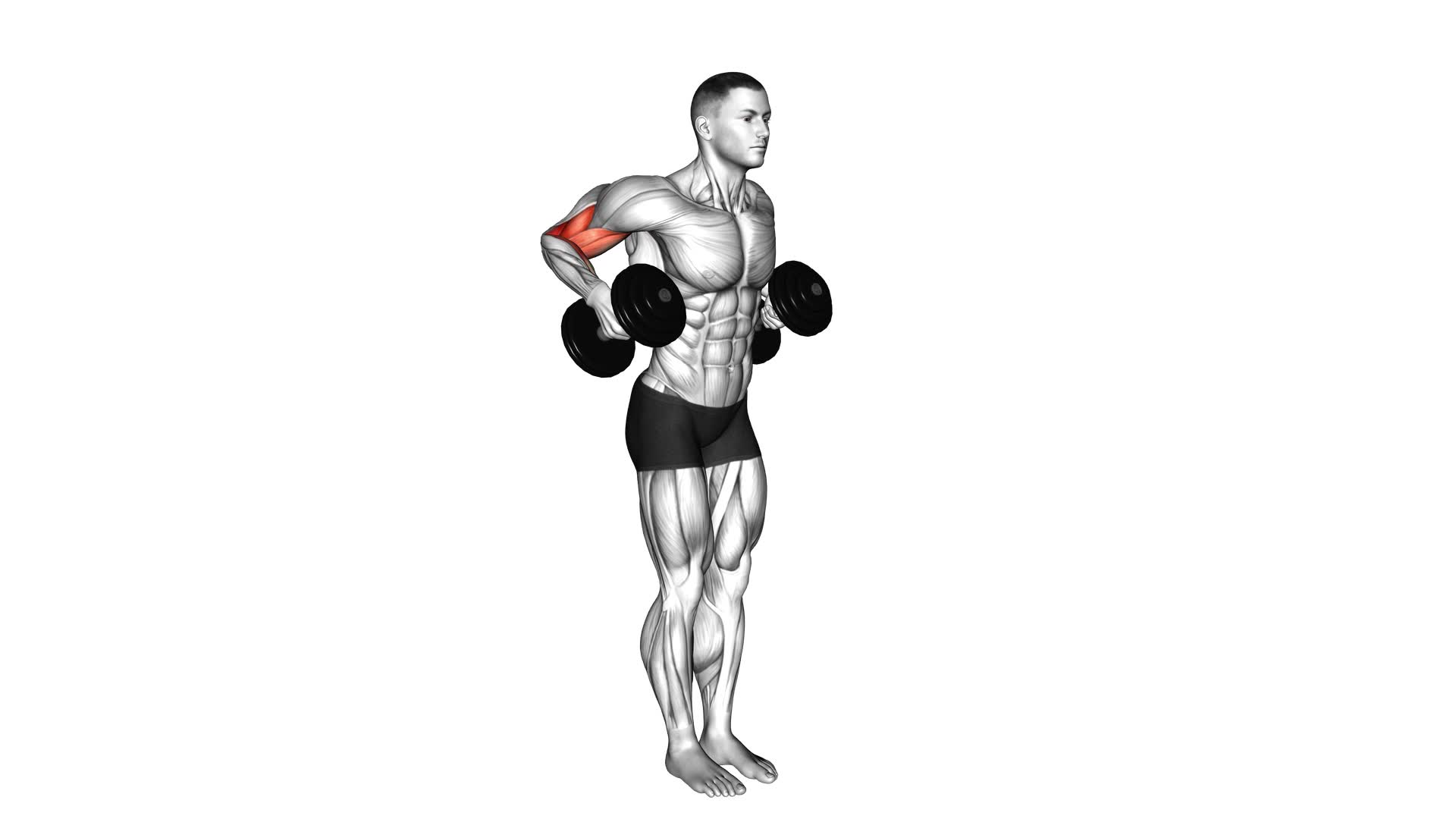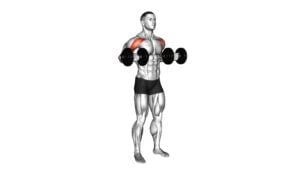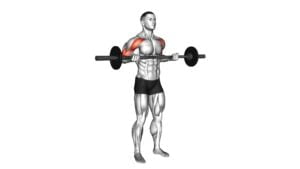Dumbbell Standing Drag Curl (VERSION 2) – Video Exercise Guide & Tips

Are you looking to level up your arm workout? Check out the Dumbbell Standing Drag Curl (Version 2)!
Watch This Exercise Video
This video exercise guide and tips will show you the proper form and technique to maximize your gains. Whether you're a beginner or a seasoned gym-goer, we've got recommended dumbbell weights for every fitness level.
Avoid common mistakes and get the most out of this exercise with our expert tips.
Get ready to feel the burn and sculpt those biceps!
Key Takeaways
- The dumbbell standing drag curl targets the biceps and forearms, improving muscle definition and strength.
- It offers a greater range of motion and promotes better posture.
- The exercise enhances grip strength and can be performed with different grips or equipment.
- Beginners should start with lighter dumbbells and gradually increase weight as strength improves, while advanced individuals can opt for heavier dumbbells based on their capabilities and goals.
Benefits of the Dumbbell Standing Drag Curl
You can maximize the benefits of the Dumbbell Standing Drag Curl by engaging both your biceps and forearms during the exercise. This particular exercise offers several advantages and can help you achieve significant gains in your arm strength and muscle development.
One of the key advantages of the Dumbbell Standing Drag Curl is that it specifically targets your biceps and forearms. By performing this exercise, you can effectively isolate and work these muscle groups, which can lead to improved muscle definition and strength gains.
Additionally, the Dumbbell Standing Drag Curl allows for a greater range of motion compared to other bicep exercises. This increased range of motion enables you to fully contract and stretch your biceps and forearms, resulting in enhanced muscle activation and growth.
Furthermore, this exercise promotes better posture and grip strength. As you perform the drag curl, you must maintain a straight back and engage your core, which helps improve your overall posture. Additionally, gripping the dumbbells firmly throughout the exercise challenges your grip strength, leading to increased forearm strength and stability.
Proper Form and Technique for the Exercise
To ensure proper form and technique for the Dumbbell Standing Drag Curl, focus on maintaining a straight back and engaging your core throughout the exercise. This will help you perform the movement correctly and maximize the benefits of the exercise.
Start by standing with your feet shoulder-width apart and holding a dumbbell in each hand with an underhand grip. Keep your elbows close to your sides and your palms facing forward. Stand up straight, with your shoulders back and your chest lifted.
As you curl the dumbbells up towards your shoulders, make sure to keep your elbows stationary. Avoid swinging your body or using momentum to lift the weights. This will help isolate your biceps and improve their strength.
Variations of the drag curl can be done by using different grips or equipment. For example, you can try using an EZ bar instead of dumbbells, or you can perform the exercise with a pronated grip (palms facing down) instead of an underhand grip. These variations can target your biceps from different angles and add variety to your workout routine.
Remember to start with a weight that's challenging but allows you to maintain proper form. Gradually increase the weight as your strength improves. By focusing on proper form and technique, you can maximize the benefits of the Dumbbell Standing Drag Curl and achieve stronger, more defined biceps.
Recommended Dumbbell Weights for Different Fitness Levels
When considering the recommended dumbbell weights for different fitness levels, it's important to continue focusing on maintaining proper form and technique for the Dumbbell Standing Drag Curl. For beginners, it's advised to start with lighter dumbbells to ensure correct execution of the exercise. This will allow the individual to gradually build strength and avoid potential injuries. A good starting point for beginners would be dumbbells ranging from 5 to 10 pounds. As the individual progresses and becomes more comfortable with the exercise, they can gradually increase the weight.
On the other hand, advanced individuals who've been consistently training and have developed a good level of strength can opt for heavier dumbbells. The recommended dumbbell weight for advanced lifters can range from 15 to 25 pounds or even higher, depending on their individual capabilities and goals. It's important to remember that the weight used should challenge the muscles without compromising proper form and technique.
Common Mistakes to Avoid During the Dumbbell Standing Drag Curl
Maintaining proper form and technique is crucial for the Dumbbell Standing Drag Curl. Avoiding common mistakes is essential for optimal results. To ensure you're performing this exercise correctly, there are a few common mistakes you should avoid.
One common mistake is using momentum to lift the dumbbells. It's important to focus on the contraction of your biceps and not rely on swinging the weights up. By using momentum, you aren't effectively targeting your biceps and may increase the risk of injury.
Another mistake is allowing your elbows to move forward during the curl. This takes the emphasis away from your biceps and shifts it to your shoulders. To prevent this, keep your elbows stationary and close to your sides throughout the movement.
Improper grip placement is also a common mistake. Make sure to hold the dumbbells with an underhand grip, palms facing up, and maintain a tight grip throughout the exercise. This will help to engage your biceps effectively.
Tips to Maximize the Effectiveness of the Exercise
To enhance the effectiveness of the Dumbbell Standing Drag Curl, focus on your grip strength and control throughout the exercise. Here are some tips to help you maximize your results and make the most out of this exercise:
- Vary your grip: Experiment with different grip widths to target different muscles. A wider grip will engage your outer biceps, while a narrower grip will focus on the inner biceps.
- Maintain proper form: Keep your elbows tucked in and close to your body throughout the movement. This will ensure that you're effectively targeting your biceps and minimizing the involvement of other muscles.
- Control the weight: Avoid swinging the dumbbells or using momentum to lift the weight. Instead, focus on a slow and controlled movement, emphasizing the contraction of your biceps.
- Gradually increase the weight: As your grip strength improves, gradually increase the weight to continue challenging your muscles and promoting growth.
- Incorporate variations and modifications: To further enhance the effectiveness of the exercise, you can try using an EZ bar instead of dumbbells or performing the drag curl while standing on a stability ball to engage your core muscles.
Frequently Asked Questions
How Many Sets and Reps Should I Do for the Dumbbell Standing Drag Curl?
To determine the number of sets and reps for the dumbbell standing drag curl, consider your fitness goals and experience level. Generally, aim for 3-4 sets of 8-12 reps to build muscle and strength.
However, you can adjust the sets and reps based on your preferences and needs.
The standing drag curl is a variation of the bicep curl that focuses on the lower portion of the bicep, giving you a challenging and effective workout.
Can I Use a Barbell Instead of Dumbbells for the Standing Drag Curl?
Yes, you can use a barbell instead of dumbbells for the standing drag curl. It's a variation of the exercise that allows for a different grip and activates the muscles in a slightly different way.
The barbell allows for a wider grip, which can target the outer biceps more. However, it's important to note that the barbell may put more strain on your wrists and forearms, so be sure to use proper form and start with lighter weights to avoid injury.
Is the Dumbbell Standing Drag Curl Suitable for Beginners?
The dumbbell standing drag curl can be a suitable exercise for beginners. It allows for a controlled movement and targets the biceps effectively.
However, if you're a beginner and find it challenging, there are alternative exercises you can try. For instance, you can start with seated dumbbell curls or use resistance bands.
It's important to avoid common mistakes such as using momentum or swinging the weights. Focus on proper form and gradually increase the weight as you become more comfortable.
How Long Should I Rest Between Sets of the Dumbbell Standing Drag Curl?
To maximize your gains and prevent injury, it's crucial to rest between sets of the dumbbell standing drag curl. Resting allows your muscles to recover and replenish energy.
Proper form is essential in this exercise to target your biceps effectively. By incorporating the dumbbell standing drag curl into your arm-focused workout routine, you can build strength and size in your biceps.
Remember to take adequate rest between sets to optimize your performance and achieve your desired results.
Can I Incorporate the Dumbbell Standing Drag Curl Into a Full-Body Workout Routine?
Yes, you can definitely incorporate the dumbbell standing drag curl into a full-body workout routine. It offers several benefits such as targeting your biceps, forearms, and upper back muscles.
This exercise helps to improve your overall upper body strength and stability. Additionally, you can modify the dumbbell standing drag curl by adjusting the weight, reps, or tempo to fit different fitness levels.
It's a versatile exercise that can be customized to suit your specific needs and goals.
Conclusion
In conclusion, the dumbbell standing drag curl is an effective exercise for targeting the biceps and building upper body strength.
By maintaining proper form and using the recommended dumbbell weights for your fitness level, you can maximize the effectiveness of this exercise.
Avoiding common mistakes and following these tips will help you get the most out of your workout.
Incorporate the dumbbell standing drag curl into your routine to see improvements in your bicep strength and overall fitness.

Author
Years ago, the spark of my life’s passion ignited in my mind the moment I stepped into the local gym for the first time. The inaugural bead of perspiration, the initial endeavor, the very first surge of endorphins, and a sense of pride that washed over me post-workout marked the beginning of my deep-seated interest in strength sports, fitness, and sports nutrition. This very curiosity blossomed rapidly into a profound fascination, propelling me to earn a Master’s degree in Physical Education from the Academy of Physical Education in Krakow, followed by a Sports Manager diploma from the Jagiellonian University. My journey of growth led me to gain more specialized qualifications, such as being a certified personal trainer with a focus on sports dietetics, a lifeguard, and an instructor for wellness and corrective gymnastics. Theoretical knowledge paired seamlessly with practical experience, reinforcing my belief that the transformation of individuals under my guidance was also a reflection of my personal growth. This belief holds true even today. Each day, I strive to push the boundaries and explore new realms. These realms gently elevate me to greater heights. The unique combination of passion for my field and the continuous quest for growth fuels my drive to break new ground.







